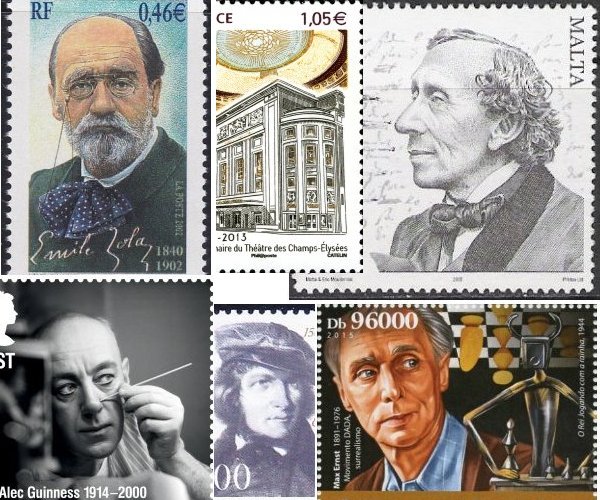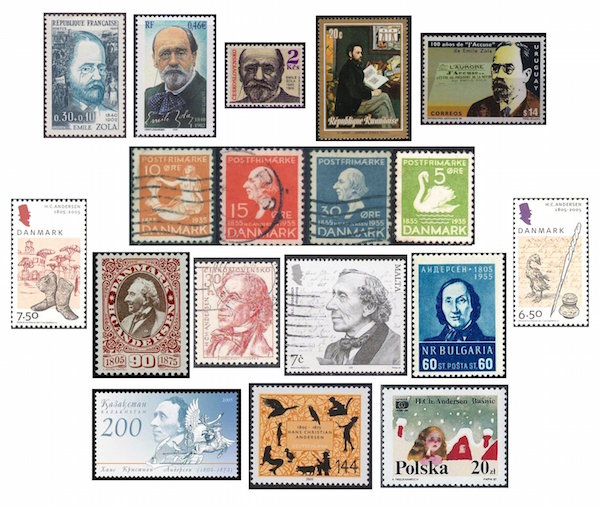The Arts on the Stamps of the World — April 2
An Arts Fuse regular feature: the arts on stamps of the world.

By Doug Briscoe
Today’s most celebrated birthday children are Émile Zola, Hans Christian Andersen, Max Ernst, Alec Guinness, and Dragnet’s Jack Webb. We also salute two nineteenth-century poets, a Filipino and a German, a Belgian tenor, and the 104th anniversary of the opening of the Théâtre des Champs-Élysées.
A few interesting factoids about the great Émile Zola (2 April 1840 – 29 September 1902). Although born in Paris, his father was an Italian from Venice, and Zola did not become a naturalized French citizen until he was 22. He was a childhood friend of Paul Cézanne. He died of carbon monoxide poisoning from “an improperly ventilated chimney,” which led some to suspect he had been murdered by someone irritated by his writings. One nasty piece of work scribbled that Zola had committed suicide on learning that Dreyfus was guilty after all. Today, of course, Zola is admired the world over, as evidenced by stamps from Czechoslovakia, Rwanda (the Manet portrait), and Uruguay as well as from France.
Also born on this date was Hans Christian Andersen (1805 – 4 August 1875). As I’ve done with some other subjects I’ll concentrate again on some the musical works that have come into being because of his writing. Schumann, Grieg, Niels Wilhelm Gade, and JPE Hartmann each set several of Andersen’s lyrics, and there are also songs by Nielsen, Delius, Honegger, and Furtwängler, among many others. Prokofiev’s early cantata “The Ugly Duckling” is based on the famous fairy tale. In fact, many of Andersen’s tales have been adapted for operas, ballets, and symphonic poems. To cite just a few of them: Zemlinsky’s tone poem “Die Seejungfrau” after “The Little Mermaid” (1905), Stravinsky’s short one-act opera Le Rossignol after “The Nightingale” (1914, rev. 1962) and the symphonic poem derived from it (The Song of the Nightingale, 1917), Ernst Toch’s opera The Princess and the Pea (1927), and Germaine Tailleferre’s opera La Petite Sirène, again after “The Little Mermaid” (1957). When Nino Rota was just 13 he penned an opera on Il Principe Porcaro (“The Swineherd”). Recent years have seen a Royal Danish Ballet production of “The Little Mermaid” (2005) and no fewer than three different ballets on “The Snow Queen” (1998, 2007, and 2012). David Lang (b. 1957) won the 2008 Pulitzer Prize with his piece “The Little Match Girl Passion”. Then, of course, there’s the great Powell and Pressburger film about ballet, The Red Shoes, with Moira Shearer and Anton Walbrook (1948). Well, there are, it seems, as many Hans Christian Andersen stamps in the world as there are Hans Christian Andersen adaptations. I show a small sample of items from Denmark, Czechoslovakia, Malta, Bulgaria, Kazakhstan, Germany, and Poland (“The Match Girl”).
German artist Max Ernst (2 April 1891 – 1 April 1976) rebelled against his father’s authoritarianism but emulated his painting. In youth he concerned himself with exploring the art work of the mentally ill. Later he associated with professional artists, so he was consistent in that. He met August Macke and Hans Arp before being called up to serve in World War I, during which he was assigned to work on maps. After the war he visited Klee and, inspired by Giorgio de Chirico, began to work on collages. Paul Éluard selected six of these to illustrate his poetry volume Répétitions. The pair worked together with André Breton on his magazine Littérature, and Ernst continued to collaborate with other prominent artists including Miró, Diaghilev, and Buñuel, even appearing in the latter’s 1930 film L’Âge d’Or. All the while Ernst experimented with a variety of techniques, developing what he called frottage (pencil rubbings) and grattage (similar, but with paint), working in decalcomania, and so on, turning to sculpture for the first time in 1934. He was both interned by the French (as an “undesirable alien”) and arrested by the Gestapo, but managed to escape and was helped by Peggy Guggenheim to get to the United States. A collaboration of another sort was his brief marriage to her from 1942 to 1946. A union with the American Surrealist artist Dorothea Tanning (they were married in a double ceremony with Man Ray!) was more enduring, lasting for thirty years until Ernst’s death. Tanning lived on until just five years ago, dying at the age of 101. The French and German stamps were issued on the same day in 1991 to commemorate the artist’s centenary. Both stamps show pieces from 1927, the French one Après nous la maternité and the German one Monument aux oiseaux. The stamps from the geographically propinquitous (to each other) Sierra Leone and Saint Thomas are drawn from minisheets issued within the last two years. The latter shows Ernst’s sculpture The King Playing With the Queen (Le roi jouant avec la reine, 1944).

The magnificent and irreplaceable Sir Alec Guinness (2 April 1914 – 5 August 2000) was born out of wedlock and was never certain of the identity of his father, assuming that that rôle belonged to a Scottish banker (named Geddes, yet) who paid for his education. After much distinctive work on the stage, Guinness served in the British Navy in World War II, at one point commanding a landing craft in the invasion of Sicily. But he also got leave to act a part on Broadway. (It was a Terence Rattigan play about the war and no doubt was thought to be a morale booster.) Other than his appearance as an uncredited extra in a 1934 movie, Guinness first appeared on screen in David Lean’s Great Expectations (1946) and went on to work with Lean on a number of unforgettable occasions, in the mean time starring in Ealing Studios comedies that are among the greatest in cinema: Kind Hearts and Coronets, in which he played eight characters, The Lavender Hill Mob, The Man in the White Suit, The Ladykillers, and so on. Surely I would be remiss not to mention his portrayal of Gulley Jimson in The Horse’s Mouth (1958). He was knighted the next year. Then along came Star Wars, and there was no turning back. I remember an anecdote he told on the Letterman show one night: a child approached for his autograph and declared he had seen Star Wars forty-five times (or some such number); Guinness rolled his eyes, sighed, and said, “I want you to make me a promise. I want you to promise me that you will never watch Star Wars again!” The child was shell-shocked, the mother horrified. Alec Guinness was married to Merula Salaman for 62 years; she died two months after he did. As for the stamps, two British issues bracket one from a US Star Wars souvenir sheet from 2007.
While we’re on the subject of actors, let’s give a tip of the hat to John Randolph Webb (April 2, 1920 – December 23, 1982), that is, Jack Webb, Sgt. Joe Friday in Dragnet. In a case reminiscent of Alec Guinness, Webb never knew his father, who abandoned Webb’s mother before Webb was born. He started in radio, doing comedy, difficult as that may be to envision. His participation in the 1948 film He Walked by Night gave him the idea for Dragnet, which ran on radio 1949 to 1957 and on television from 1952 to 1959, with a resurrection in 1967 that lasted until 1970. Webb was all set to dust off the series again for the 1983 season, but died before the project could get off the ground. He also founded a production company and was a director and writer.
The important Filipino poet Francisco Baltazar (1788 – February 20, 1862) was born with the name Balagtas, but was required by law to change it—an 1849 edict demanded that native peoples assume Spanish names. He wrote his poems, however, in Tagalog. It seems he fell in love with a woman who was also the object of a rich man’s affections with the result that Balagtas was imprisoned on trumped up charges. While incarcerated, he wrote his masterpiece Florante at Laura (1838), an epic poem set in the Middle Ages. It follows the exacting rules of the Filipino poem form the awit, namely, with each stanza of four lines (twelve syllables per line with a caesura after the sixth syllable) observing a specific assonant rhyme scheme and usually consisting of a single complete sentence.

Born ten years later to the day after Baltazar was August Heinrich Hoffmann von Fallersleben (2 April 1798 – 19 January 1874). He, too, fell afoul of powerful forces when he was dismissed from his professorship at Breslau University after writing some politically dubious poems. These were the Unpolitische Lieder (“Unpolitical Songs”) of 1840–41. This story had a happy ending, though, or at least a just one, as his position was restored after some six years of travel. One of the poems from this set is the one that begins “Deutschland, Deutschland über alles,” an expression of yearning, not for world domination, with which it certainly later came to be associated, but for the unification of Germany from its patchwork of minor principalities. As such, the sentiment was regarded (by the patchwork princes) as treasonous. The song, set to much older music by Haydn, is still Germany’s national anthem, but with a revised text, the first two stanzas now being omitted. Hoffmann himself wrote melodies to some of his poems and was highly regarded by his contemporaries, including Schumann, Mendelssohn, Brahms, and Liszt, all of whom set Hoffmann’s poetry to music. He is also well known for his children’s songs, which remain popular in Germany to this day.
April 2nd is the birthday of Belgian operatic tenor Ernest van Dyck (Dijck) (1861 – 31 August 1923). A close friend of Chabrier, he was the first Werther (Massenet) in 1892 and took part in in the first performance of Debussy’s cantata “L’enfant prodigue” (1884). Particularly associated with the Wagnerian repertoire, van Dyck sang at the Met from 1898 to 1902. A few acoustic recordings survive.
On April 2, 1913 the Théâtre des Champs-Élysées opened with a gala concert in which five of France’s most distinguished composers conducted their own works: Debussy (Prélude à l’après-midi d’un faune), Dukas (L’apprenti sorcier), Fauré (La naissance de Vénus), d’Indy (Wallenstein’s Camp), and Saint-Saëns (Phaeton and excerpts from his choral work “La lyre et la harpe”). Now that would have been something to see. The next day Felix Weingartner led a performance of Berlioz’s Benvenuto Cellini, and Anna Pavlova danced.
Several interesting creators born on this day but not yet on stamps deserve a mention, I think: Giacomo Casanova (2 April 1725 – 4 June 1798), English Pre-Raphaelite painter William Holman Hunt (1827 – 7 September 1910), Scottish author of the rambunctious Flashman novels George MacDonald Fraser (1925 – 2 January 2008), and English theater critic Kenneth Tynan (1927 – 26 July 1980).
According to Wikipedia, the “Electric Theatre,” “the first full-time movie theater in the United States,” opened on April 2, 1902.
A graduate of the University of Massachusetts with a B.A. in English, Doug Briscoe worked in Boston classical music radio, at WCRB, WGBH, and WBUR, for about 25 years, beginning in 1977. He has the curious distinction of having succeeded Robert J. Lurtsema twice, first as host of WGBH’s weekday morning classical music program in 1993, then as host of the weekend program when Robert J.’s health failed in 2000. Doug also wrote liner notes for several of the late Gunther Schuller’s GM Recordings releases as well as program notes for the Boston Classical Orchestra. For the past few years he’s been posting a Facebook “blog” of classical music on stamps of the world, which has now been expanded to encompass all the arts for The Arts Fuse.

Another treasure trove! And, oh, the talent, discipline, and honed skill required to put this together!
[…blushing…] Sweet of you. Thanks!